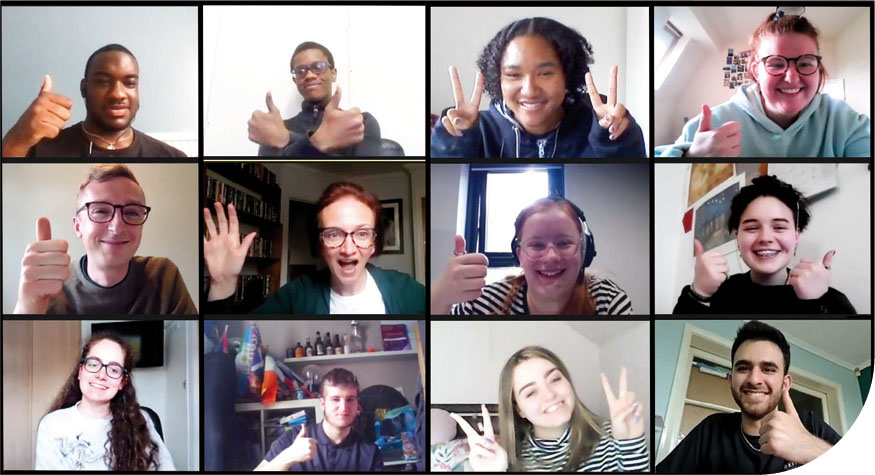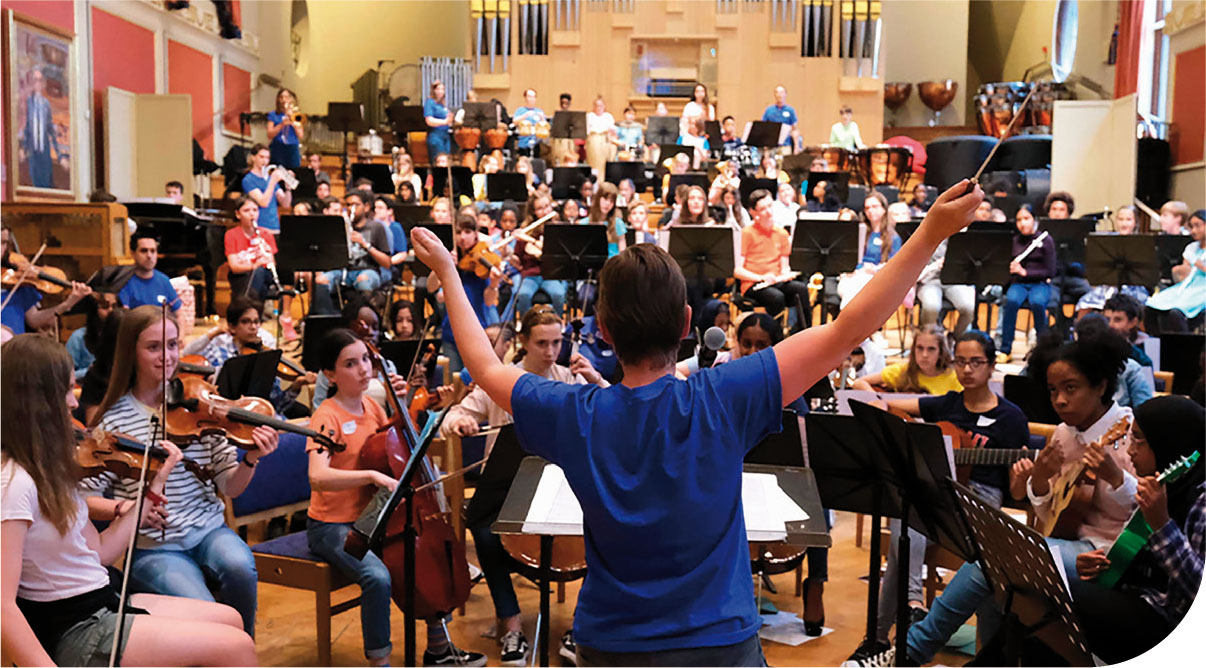
Orchestras for All (OFA) celebrated its recent five-year strategy announcement with the launch of a bold new visual identity designed in collaboration with their new board of young trustees. After a year of adapting their offer to make sure they were still reaching young people during the various Covid restrictions, the launch seemed to be not just a celebration of an ambitious new business plan, but also a real joy at seeing young people as vibrantly engaged with music making as ever.
Donna Edmonds, head of programmes at OFA, says: ‘We made a decision last year that Covid wasn't going to stop us – we would just find a way around it, through it, over it, under it – whatever we could do to keep bringing music to the young people that we work with’. Since the normal way of bringing young people together for four- or five-day residential courses was suspended, the organisation had to think about ways, as Edmonds explains, to continue to deliver its offer but also find ways of checking in with the young people more frequently. ‘This year we have actually put on an additional number of courses – short weekend courses – to keep the repertoire going and keep the practice going, yes, but mainly for wellbeing. They have needed that space for something outside of school. With Covid and lockdown anxiety, to be able to come together with their brothers and sisters and know they're still out there thinking about them; to be able to come together and do something they love is really important.’
Rewarding experiences
Wellbeing has climbed steadily up the agenda for the organisation given the circumstances of the young people they work with. In order to join the National Orchestra for All (NOFA), there is no audition but instead a recommendation from a music teacher who thinks the young person has the enthusiasm to benefit from the opportunity and normally faces significant barriers to music making with others. Urging others to support orchestral music making, NOFA clarinettist Joe says: ‘Coming from a working-class background, classical music seemed so inaccessible. It just seemed like something for the rich and wealthy. You could learn but weren't given the opportunity to unless you had the money.’
Many of the young musicians also face health barriers, with 55 per cent previously unable to play in an orchestra due to factors including autism, a physical disability, learning or behavioural difficulties. But when young musicians join the National Orchestra for All, they can leave their worries and responsibilities at the door. Violinist, NOFA ambassador and young carer Isaac says: ‘Being a NOFA member gave me some of the most rewarding experiences of my life. You play great music, you meet amazing people – and there's a tonne of support, so that any problems you have can be dealt with.’ Current NOFA member and viola player Hannah adds: ‘It means a lot to me because I was able to gain my confidence and speak to new people. It encouraged me to share my ideas.’
Youth voice
Sharing ideas and listening to the young people is something OFA seeks to keep right at the centre of its mission – and it is putting its money where its mouth is. Young trustee Beth says: ‘I've seen organisations who say they've got youth voice, but they will have one meeting a year and that will be that. But with OFA, we have me and Joelle on the trustee board, and the entire board are meeting up regularly after every single NOFA session.’

A youth board meeting, May 2021
The recent rebranding is a prime example of their involvement. Gone are the wordy descriptions on each page of the website, replaced with snappy summaries and vibrant, modern colours. ‘We try to keep things as diverse as possible, so we do have some people on the board who are dyslexic or have ADHD,’ Beth explains. ‘They were able to have a read and say, “Look, could you word this differently because I struggle to understand it?”.’ The young people were consulted from the word go about key words, catchphrases, and the overall look, making their impact felt with the rebranding after just two youth board meetings.
The Great Interstellar Orchestra
A captivating new digital piece, named The Great Interstellar Orchestra by young musicians, was released in June after the NOFA Spring sessions and is another wonderful example of OFA turning the limitations of the past 18 months into opportunity. Composer Jack McNeill and digital visual artist Bryony Simcox worked with the young people on collage and remixing over four days of workshops. The creations and stories that emerged became the basis of the audiovisual composition.
Speaking about the music, McNeill explains: ‘The Great Interstellar Orchestra is all about giving young people a voice and showcasing their creativity, and that's exactly what this piece does. The audio track is constructed (almost) exclusively of the NOFA members’ own recordings, processed, chopped up and warped to create this digital ensemble. Within the texture, every single sound that was sent has been included in some way and every member has an important role and voice within the team.’
Talking about her approach to the artwork, Simcox says: ‘As well as pattern and colour, the overarching structure of the piece was curated by NOFA members, who used storyboarding in Zoom to imagine ways to tell the story of the orchestra. First, the disparate pieces emerge, just as each NOFA member comes together from different backgrounds and corners of the country. As the video continues, we use tunnels, car rides, cogs and train journeys – all literal imagery suggested by the young people to reflect the idea of coming together.’
Leading by example
The themes of diversity and coming together, illustrated so effectively by the piece, run through everything OFA does. Time and again young people say how exciting it is to play in a large ensemble, to be surrounded by other musicians and to play ‘as one’. Beth describes it as, ‘that real, tight family feel of everyone coming together from around the UK and being part of this one thing, no matter what else we've got going on.’
For 16-year-old pianist Troy, the digital piece highlights a vision for the future: ‘I'm really happy that I was a part of it and that I was able to contribute to all of this. It will show [others] how we're all going on a journey – where we are, what we want to do, and what we want to achieve.’ Helping young people see pathways to success, however that may be defined, is something Edmonds is passionately behind: ‘It's so important, coming from my background as a headteacher, that [OFA] cares about wellbeing and mentoring. As well as putting together fantastic music making opportunities, they really are making sure that the young people they are working with are going to progress more in their lives because of taking part in this project.’

The National Orchestra for All
Looking to the future
Now with a professional and more ambitious fundraising strategy, the organisation can apply for some substantial grants. They are looking to appoint a wellbeing lead and, for the first time in July, they will be able to provide a professional mentor on a NOFA course. As Edmonds says: ‘It's music, it's social mobility, and it's broadening those horizons and just saying, “Those aspirations that you have can be realised and we're going to walk that journey with you”.’
As young trustee Beth is the first person in her family to complete her school education and go on to university, her words – spoken during a call from her university accommodation – seem all the more poignant. ‘I truly believe we've got some powerful change going on at the moment. We've got a great opportunity for progression and growth – from the youth voice. It's bittersweet regarding how we develop OFA. We'd love to grow more and expand the cohort of musicians that we can offer the programmes to, but in an ideal world our organisation shouldn't have to exist at all. In an ideal world, those barriers would not exist anymore.’ For now, let's spread the word and make sure as many young musicians as possible can enjoy the opportunities offered by Orchestras for All.









